Related Research Articles

Salamanders are a group of amphibians typically characterized by a lizard-like appearance, with slender bodies, blunt snouts, short limbs projecting at right angles to the body, and the presence of a tail in both larvae and adults. All present-day salamander families are grouped together under the order Urodela. Salamander diversity is most abundant in the Northern Hemisphere and most species are found in the Holarctic ecozone, with some species present in the Neotropical zone.

Amplexus is a type of mating behavior exhibited by some externally fertilizing species in which a male grasps a female with his front legs as part of the mating process, and at the same time or with some time delay, he fertilizes the eggs as they are released from the female's body. In amphibians, females may be grasped by the head, waist, or armpits, and the type of amplexus is characteristic of some taxonomic groups. Amplexus involves direct contact between male and female, distinguished from other forms of external fertilization such as broadcast spawning, where sperm and eggs are freely shed into water without direct contact by individuals.
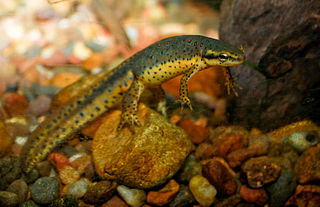
The eastern newt is a common newt of eastern North America. It frequents small lakes, ponds, and streams or near-by wet forests. The eastern newt produces tetrodotoxin which makes the species unpalatable to predatory fish and crayfish. It has a lifespan of 12 to 15 years in the wild, and may grow to five inches in length. These animals are common aquarium pets, being either collected from the wild or sold commercially. The striking bright orange juvenile stage, which is land-dwelling, is known as a red eft. Some sources blend the general name of the species and that of the red-spotted newt subspecies into the eastern red-spotted newt.
The Siskiyou Mountains salamander, Plethodon stormi, also called the Siskiyou Mountain salamander, exists only in isolated locations along the Klamath River in northern California and southern Oregon. It is a close relative of the Del Norte salamander, and some herpetologists believe it may be a subspecies of that animal.
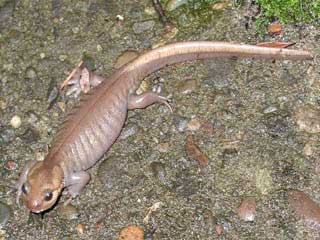
The northwestern salamander inhabits the northwest Pacific Coast of North America. These fairly large salamanders grow to 8.7 in (220 mm) in length. It is found from southeastern Alaska on May Island, through Washington and Oregon south to the mouth of the Gulala River, Sonoma County, California. It occurs from sea level to the timberline, but not east of the Cascade Divide. Its range includes Vancouver Island in British Columbia and The San Juan Islands, Cypress, Whidbey, Bainbridge, and Vashon Islands in Washington.
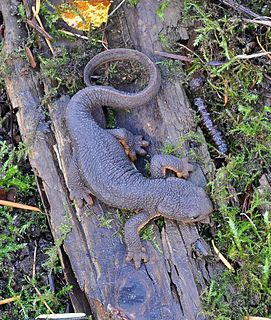
The rough-skinned newt or roughskin newt is a North American newt known for the strong toxin exuded from its skin.

The California newt or orange-bellied newt, is a species of newt endemic to California, in the Western United States. Its adult length can range from 5 to 8 in. Its skin produces a potent toxin.

The Mount Jefferson Wilderness is a wilderness area located on and around Mount Jefferson in the central Cascade Range of Oregon in the United States. It is situated where the Willamette, Deschutes, and Mount Hood National Forests meet. Mount Jefferson Wilderness is the second most visited Oregon wilderness area after the Three Sisters Wilderness.

Planorbella is a genus of freshwater air-breathing snails, aquatic pulmonate gastropod mollusks in the family Planorbidae, the ram's horn snails, or planorbids, which all have sinistral, or left-coiling, shells.

Glossiphoniidae are the family called freshwater jawless leeches or glossiphoniids. They are one of the main groups of Rhynchobdellida, true leeches with a proboscis. These leeches are generally flattened, and have a poorly defined anterior sucker. Most suck the blood of freshwater vertebrates like amphibians and aquatic turtles, but some feed on the hemolymph of invertebrates like oligochaetes and freshwater snails instead.
The Tulameen River is a tributary of the Similkameen River in the Canadian province of British Columbia. The Tulameen River is part of the Columbia River drainage basin, being a tributary of the Similkameen River, which flows into the Okanagan River, which flows into the Columbia River.

A newt is a salamander in the subfamily Pleurodelinae. The terrestrial juvenile phase is called an eft. Unlike other members of the family Salamandridae, newts are semiaquatic, alternating between aquatic and terrestrial habitats. Not all aquatic salamanders are considered newts, however. More than 100 known species of newts are found in North America, Europe, North Africa and Asia. Newts metamorphose through three distinct developmental life stages: aquatic larva, terrestrial juvenile (eft), and adult. Adult newts have lizard-like bodies and return to the water every year to breed, otherwise living in humid, cover-rich land habitats.
The Crater Lake newt or Mazama newt, Taricha granulosa mazamae, is a subspecies of the rough-skinned newt. Its type locality is Crater Lake, Oregon. Similar newts have been found in Alaska, but their identity is unclear.
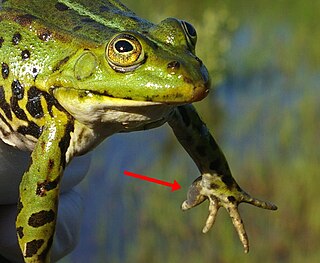
A nuptial pad is a secondary sex characteristic present on some mature male frogs and salamanders. Triggered by androgen hormones, this breeding gland appears as a spiked epithelial swelling on the forearm and prepollex that aids with grip, which is used primarily by males to grasp females during amplexus. They can also be used in male-male combat in some species.
Megalobatrachonema is a nematode genus. Species of this genus are parasites of a number of amphibians including the rough-skinned newt.
Karotomorpha is a genus of parasites with a flagellum structure. This organism can infect a variety of higher life forms including a number of amphibians. For example, this genus is known to be a parasite of the rough-skinned newt, a widespread newt in the western USA.
Cephalouterina is a genus of trematodes within the family Lecithodendriidae under the order Plagiorchiida. Individuals of this genus are known to use amphibian hosts.
Cephalouterina decamptodoni is a species of trematodes within the family Lecithodendriidae under the order Plagiorchiida. This species is sometimes known to use amphibian hosts.
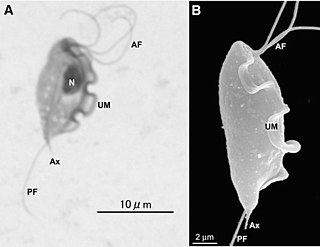
Tritrichomonas is a genus of single celled flagellated parasitic excavates, some of whose species are known to be pathogens of the bovine reproductive tract as well as the intestinal tract of felines.

The Bedded Range is a mountain range in the Hozameen Range subdivision of the Canadian Cascades, which are the extension of the Cascade Range into British Columbia, Canada. Located between the Coquihalla and Tulameen Rivers, the Bedded Range is a dioritic plug related to the Chilliwack batholith.